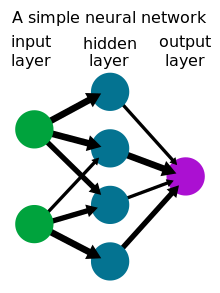The term neural network was traditionally used to refer to a network or circuit of biological neurons. The modern usage of the term often refers to artificial neural networks, which are composed of artificial neurons or nodes. Thus the term has two distinct usages:
Biological neural networks are made up of real biological neurons that are connected or functionally related in the peripheral nervous system or the central nervous system. In the field of neuroscience, they are often identified as groups of neurons that perform a specific physiological function in laboratory analysis.
Artificial neural networks are made up of interconnecting artificial neurons (programming constructs that mimic the properties of biological neurons). Artificial neural networks may either be used to gain an understanding of biological neural networks, or for solving artificial intelligence problems without necessarily creating a model of a real biological system. The real, biological nervous system is highly complex and includes some features that may seem superfluous based on an understanding of artificial networks.
This article focuses on the relationship between the two concepts; for detailed coverage of the two different concepts refer to the separate articles: Biological neural network and Artificial neural network.
Overview
In general a biological neural network is composed of a group or groups of chemically connected or functionally associated neurons. A single neuron may be connected to many other neurons and the total number of neurons and connections in a network may be extensive. Connections, called synapses, are usually formed from axons to dendrites, though dendrodendritic microcircuits and other connections are possible. Apart from the electrical signaling, there are other forms of signaling that arise from neurotransmitter diffusion, which have an effect on electrical signaling. As such, neural networks are extremely complex.
Artificial intelligence and cognitive modeling try to simulate some properties of neural networks. While similar in their techniques, the former has the aim of solving particular tasks, while the latter aims to build mathematical models of biological neural systems.
In the artificial intelligence field, artificial neural networks have been applied successfully to speech recognition, image analysis and adaptive control, in order to construct software agents (in computer and video games) or autonomous robots. Most of the currently employed artificial neural networks for artificial intelligence are based on statistical estimation, optimization and control theory.
The cognitive modelling field involves the physical or mathematical modeling of the behaviour of neural systems; ranging from the individual neural level (e.g. modelling the spike response curves of neurons to a stimulus), through the neural cluster level (e.g. modelling the release and effects of dopamine in the basal ganglia) to the complete organism (e.g. behavioural modelling of the organism's response to stimuli). Artificial intelligence, cognitive modelling, and neural networks are information processing paradigms inspired by the way biological neural systems process data.
skip to main |
skip to sidebar
Blog Artikel Teknologi Informasi (TI), Game, dan Design. Semoga Indonesia semakin maju.
Pages
About Me
- Arie Setiawan
- Arie Setiawan, pekerjaan sebagai Dosen di Fakultas Teknologi Informasi, UKSW - Salatiga. S2: Ilmu Komputer UGM S1: Teknik Elektro UKSW SMA : SMA Lab UKSW
Powered by Blogger.




